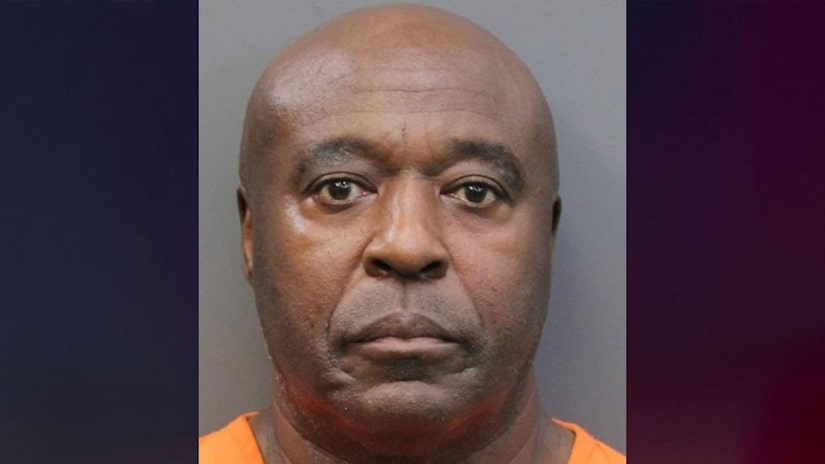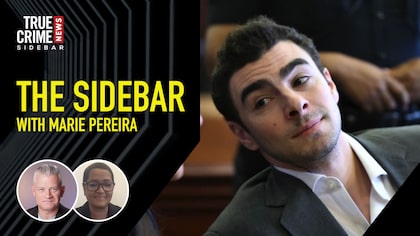GUILTY or INNOCENT? The Conviction of Rodney Lincoln
11/24/2015 5:09 pm PST

By Ron Zimmerman & Michelle Sigona
Has convicted killer Rodney Lincoln been locked up in prison three decades for a murder committed by someone else — serial killer Tommy Lynn Sells?
That's the burning question posed by our one-hour mystery special that aired Monday on Crime Watch Daily.
Here's a behind-the-scenes story on how our reporting of this case unfolded:
RON ZIMMERMAN, PRODUCER
We started on a completely different path on this story for Crime Watch Daily. In the beginning, we didn't even know Rodney's name. We did, however, know true-crime author Diane Fanning. She had spent many hours interviewing serial killer Tommy Lynn Sells in Texas. In 2000, Sells killed a young Texas girl in a nighttime attack. We did that story for ABC and for the show America's Most Wanted.
MICHELLE SIGONA, CORRESPONDENT
What was new was that Diane's book on that murder spree, Through the Window, also contained Tommy's claims that he had committed many other murders, and he knew that innocent people had been convicted for some of his homicides. He told Fanning, “I don't care.”
Tommy Sells may not have cared — but we did.
Sells' claims in Fanning's book hit like a constitutional cluster bomb. Prosecutors scrambled and convicted prisoners were freed. In one Illinois case, Fanning was lauded for gaining the freedom of Julie Rae Harper, who was serving 65 years for killing her son Joel. But Harper didn't do it. Tommy Lynn Sells did. Julie fought with Sells in her home, but the county prosecutor wouldn't believe her. In a terrible injustice, she was prosecuted and went to prison before a retrial based on Sells' confession led to her exoneration.
RON ZIMMERMAN
I drove to a small Virginia town to interview Diane Fanning. Our piece was going to be a simple one: Diane and Texas Ranger Captain Johnny Allen. Allen had arrested Sells in 2000, and he was the first person Tommy spilled his guts to about his homicides. Sells swore that he had strangled, stabbed, shot and bludgeoned nearly 80 people. Ranger Allen then spent three years taking Sells to the original murder sites, and stopped counting once he tied Tommy to two dozen murders.
Originally we were simply going to tell Fanning's role in tying Tommy Sells to the Julie Rae Harper case. But Crime Watch Daily Executive Producer Scott Eldridge is always thinking bigger — he asked us: If Tommy said there are people all across the country in jail for his crimes, then surely isn't there another case that hasn't yet been reported?
That's when our story took an incredible turn.
Diane Fanning's private investigator Bill Clutter knew of a case that had Tommy's M.O.: That of a quiet fellow still in a Missouri prison, Rodney Lincoln.
MICHELLE SIGONA
It seemed clear cut. A young girl horrifically attacked in her home, her mother dead. Once we dove in, it all blurred. It became much, much more.
RON ZIMMERMAN
When the warden of Missouri's state penitentiary approved our request, Michelle got the story. Michelle, like the rest of Crime Watch Daily's reporters, is dedicated and tireless. But she's the only one on the reporting staff with a month-old newborn while she flies around the country. That's a measure of her tenacity and commitment.
MICHELLE SIGONA
The morning I met Rodney, I flew to Missouri, and the road on which his prison is located is, appropriately, named “No More Victims Road.”
Lincoln had never given a television interview. Would he be honest? Would his words be true? I was not there that day to judge Rodney Lincoln, only to hear him out.
Lincoln walked through the door. He wasn't very tall. He's somewhat frail, wearing large glasses. I reminded myself why he was there — for the brutal murder of an innocent mother and slashing of two very young girls.
His sincerity set me back. You had to wonder if the jury got it right. In fact, the first jury on Lincoln's case felt the same way — they couldn't decide to convict and the jurors were hung. It took a second jury to convict him.
RON ZIMMERMAN
For the first time ever in a television interview, Rodney Lincoln told his story. You yourself can look into his eyes and decide if he's telling the truth. Watch our story.
From Rodney's prison in Missouri, we then drove directly to meet the survivor of the horrific attack — Melissa Davis DeBoer. It was the first time she's ever spilled her heart out.
MICHELLE SIGONA
Melissa was nervous.
Frankly, the details she shared with me were devastating.
People choose to tell their story for various reasons. Melissa feels she's been the voice not only for herself, but also for her mom and for her younger sister.
I'm not going to go into the details here about what Melissa told me on the day we met ... I'm going to leave that for the story. But I don't think I've ever cried that hard during an interview.
RON ZIMMERMAN
In other wrongful conviction cases, it's eyewitness misidentifications that are overwhelmingly the reason for convictions being overturned. So prosecutors now know they have to rely much more upon objective evidence, such as DNA testing. In JoAnn Tate's murder, there was almost no physical evidence. So Melissa's first-hand account played an outsized role in securing Rodney Lincoln's conviction.
MICHELLE SIGONA
Melissa looked me square in my eyes and told me without a doubt the person who harmed her is Rodney Lincoln. Melissa feels victimized all over again when people question what she saw that night.
I won't ever question what Melissa went through. But we have to take a look at this case as a whole.
RON ZIMMERMAN
Diane Fanning told us that Tommy acted strangely when she asked him about his time in St. Louis, where he would always return after drifting across the country. She said he told her, “I don't want to talk about the murders I did in St. Louis. I still have family there.”
MICHELLE SIGONA
So Tommy had admitted to her that he committed more than one murder in St. Louis. Tommy was also right-handed, according to Diane.
RON ZIMMERMAN
We interviewed Johnny Allen who had gotten Tommy Sells' original confession. Allen was shocked, when while in handcuffs Tommy said, “Do you want to know about all them other murders?” “Tell me all about this one,” Allen said, “Then we'll get to the rest.”
Allen later would check Sells out of Death Row and take long drives with him to locations where he said he killed his victims. Allen says Sells was truthful, up until the point when he got angry with the rangers for reading him his Miranda rights. That's when road trips were over.
He had led the rangers to the sites of nearly 30 murders.
Are there are more victims out there? “I know there's more,” says Allen. "Lot's more. But obviously [now that Sells has been executed], we won't ever know.”
MICHELLE SIGONA
According to Ranger Allen, Tommy Lynn Sells killed people in 12 different states. That's the most difficult kind of killer for law enforcement to track — a random killer.
RON ZIMMERMAN
We started tracking Tommy's actions in St. Louis in 1982 at his mother's house. That's less than 10 miles between his house and JoAnn's — a short distance for someone used to traveling coast-to-coast.
MICHELLE SIGONA
The crime happened in the wee hours of the morning. The killer entered the family's apartment, spent time killing JoAnn and abusing Melissa. Then he took even more time to carefully wash up his weapons, smoke a cigarette and watch TV. It was a miracle Melissa and her sister survived.
RON ZIMMERMAN
Melissa said in her first interview conducted by a police detective her mother met a man the day before in the park down the street and invited him over. He drove a white Volkswagen and that day he worked on her mother's car, she said.
MICHELLE SIGONA
That might be significant, because Tommy Sells hung around parks. According to true-crime writer Diane Fanning, Sells admitted kidnapping other girls from playgrounds. And at the time of the murder, he was working in his brother's St. Louis Volkswagen repair shop, where he had access to a white VW Bug.
RON ZIMMERMAN
We do know that Rodney Lincoln had an alibi witness who corroborates his alibi that he was home the entire night of the murder. But they weren't believed by the second jury, in favor of Melissa's heart-wrenching story.
We did find evidence mentioned in police files that could solve the puzzle. A fingerprint was left on a murder weapon after the attack. The print didn't come from Lincoln, so the obvious question is, whose bloody fingerprint is it? If it's Sells', then what was he doing in the apartment? The State of Texas has a full set of Sells' prints on file, and it would be a quick matter to compare them to the print that has been in investigators' files since 1982.
MICHELLE SIGONA
We asked St. Louis Circuit Attorney Jennifer Joyce in person if she would promise us to have the fingerprint evidence compared to Tommy Sells. She hasn't yet delivered on her promise to us. In fact, this is her office's response from last week: “In 2012 ... the visual patent prints of the murder weapon were analyzed and determined to be of no value for identification.” So despite her assurance to us, the St. Louis prosecutor's office has simply refused at this time to compare the prints and DNA to Tommy Sells.
RON ZIMMERMAN
It's understandable that Jennifer Joyce's office in St. Louis wants to keep the door shut on this case from long ago.
We don't disagree, and we've been careful with the victims' psyches. But there is the possibility there are more surviving victims of the 1982 crime. Certainly Melissa Davis is a victim. But please understand, Rodney Lincoln may have been one too.
There's one more piece of evidence that can be teased out, even at this late date, 34 years after the crime.
Was the killer right-handed or left-handed?
JoAnn Tate's autopsy report in the police file is only a summary. The full autopsy report is missing.
From that full report, however, an independent forensic pathologist might be able to tell which direction most of the stab wounds came from, which would determine the dominant hand of the attacker. It might not tell you precisely who the attacker was, but it's one more data point in determining who didn't do the crime.
We know Tommy Lynn Sells was right-handed. Rodney Lincoln is left-handed.
Our special one-hour Crime Watch Daily episode aired Monday, November 23 and uncovers new revelations about evidence in the case. To view the story online, scroll below. For more Crime Watch Daily segments, visit our video page.
Ron Zimmerman is a director and cinematographer who was on the team of the program “America's Most Wanted” from its very beginning to its end. He now works freelance for “Crime Watch Daily.”
Michelle Sigona is a correspondent for “Crime Watch Daily.” She also worked on “America's Most Wanted” and is a volunteer firefighter.





